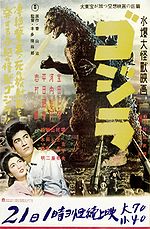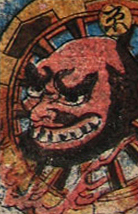Fantasy Art 1 Monster Dead but Another Bigger Monster

A monster is a type of fictional beast found in horror, fantasy, science fiction, folklore, mythology and organized religion. Monsters are very often depicted equally unsafe and ambitious with a foreign, grotesque advent that causes terror and fear. Monsters unremarkably resemble baroque, plain-featured, otherworldly and/or mutated animals or entirely unique creatures of varying sizes, but may as well take a human form, such as mutants, ghosts and spirits, zombies or cannibals, amid other things. They may or may not have supernatural powers, but are usually capable of killing or causing some form of destruction, threatening the social or moral club of the human world in the process.
Fauna monsters are outside the moral gild, but sometimes have their origin in some human violation of the moral police (e.chiliad. in the Greek myth, Minos does non sacrifice to Poseidon the white bull which the god sent him, so equally punishment Poseidon makes Minos' wife, Pasiphaë, fall in love with the bull. She copulates with the brute, and gives birth to the man with a bull's head, the Minotaur). Human monsters are those who by birth were never fully homo (Medusa and her Gorgon sisters) or who through some supernatural or unnatural act lost their humanity (werewolves, Frankenstein's monster), and so who can no longer, or who never could, follow the moral law of human society.
Monsters may too exist depicted as misunderstood and friendly creatures who affright individuals away without wanting to, or may be so big, potent and impuissant that they cause unintentional damage or death. Some monsters in fiction are depicted as mischievous and boisterous merely not necessarily threatening (such as a sly goblin), while others may be docile but prone to condign aroused or hungry, thus needing to exist tamed and taught to resist savage urges, or killed if they cannot exist handled or controlled successfully.
Monsters pre-date written history, and the academic study of the particular cultural notions expressed in a society's ideas of monsters is known as monstrophy.[1] Monsters have appeared in literature and in feature-length films. Well-known monsters in fiction include Count Dracula, Frankenstein's monster, werewolves, demons, mummies, and zombies.
Etymology [edit]

A polemical apologue presented as a five-headed monster, 1618
Monster derives from the Latin monstrum, itself derived ultimately from the verb moneo ("to remind, warn, instruct, or foretell"), and denotes anything "strange or singular, contrary to the usual form of nature, by which the gods give notice of evil," "a strange, unnatural, hideous person, brute, or thing," or whatsoever "monstrous or unusual thing, circumstance, or adventure."[2]
Cultural heritage [edit]
In the words of Tina Marie Boyer, assistant professor of medieval German literature at Wake Forest University, "monsters practise not sally out of a cultural void; they have a literary and cultural heritage".[three]
In the religious context of ancient Greeks and Romans, monsters were seen equally signs of "divine displeasure", and it was thought that nativity defects were especially ominous, being "an unnatural outcome" or "a malfunctioning of nature".[iv]
Monsters are not necessarily abominations however. The Roman historian Suetonius, for instance, describes a snake's absence of legs or a bird's ability to wing as monstrous, every bit both are "against nature".[5] Nevertheless, the negative connotations of the word quickly established themselves, and past the playwright and philosopher Seneca's time, the word had extended into its philosophical meaning, "a visual and horrific revelation of the truth".[6]
In spite of this, mythological monsters such as the Hydra and Medusa are not natural beings, but divine entities. This seems to exist a holdover from Proto-Indo-European faith and other conventionalities systems, in which the divisions betwixt "spirit," "monster," and "god" were less evident.
Monsters in fiction [edit]
Prose fiction [edit]
The history of monsters in fiction is long, for case Grendel in the epic poem Beowulf is an archetypal monster, plain-featured, brutal, with enormous strength and raiding a human settlement nightly to slay and feed on his victims. The modern literary monster has its roots on examples such equally the monster in Mary Shelley'south Frankenstein and the vampire in Bram Stoker's Dracula.
Monsters are a staple of fantasy fiction, horror fiction or scientific discipline fiction (where the monsters are oftentimes extraterrestrial in nature). There is also a subgenre of erotic fiction involving monsters, monster erotica.
Movie [edit]
Pre–World War II monster films [edit]

Hollywood's interpretation of Frankenstein'south monster, played past Boris Karloff
During the age of silent films, monsters tended to be human-sized, e.g. Frankenstein'due south monster, the Golem, werewolves and vampires. The film Siegfried featured a dragon that consisted of finish-movement blithe models, as in RKO's Rex Kong, the first giant monster picture of the audio era.
Universal Studios specialized in monsters, with Bela Lugosi'south reprisal of his stage part, Dracula, and Boris Karloff playing Frankenstein's monster. The studio also made several lesser films, such as Human-Made Monster, starring Lon Chaney, Jr. equally a carnival side-prove worker who is turned into an electrically charged killer, able to dispatch victims merely by touching them, causing death by electrocution.
In that location was also a variant of Dr. Frankenstein, the mad surgeon Dr. Gogol (played by Peter Lorre), who transplanted hands that were reanimated with malevolent temperaments, in the picture Mad Love.
Werewolves were introduced in films during this period, and similar creatures were presented in Cat People. Mummies were cinematically depicted as fearsome monsters as well. As for giant creatures, the cliffhanger of the commencement episode of the 1936 Flash Gordon series did not utilize a costumed actor, instead using real-life lizards to draw a pair of battling dragons via employ of camera perspective. However, the cliffhanger of the ninth episode of the aforementioned serial had a human in a rubber suit play the Fire Dragon, which picks up a doll representing Wink in its claws. The cinematic monster bicycle eventually wore thin, having a comedic turn in Abbott and Costello Meet Frankenstein (1948).
Postal service–Earth War Two monster films [edit]

In the post–Globe War II era, nonetheless, giant monsters returned to the screen with a vigor that has been causally linked to the development of nuclear weapons. I early instance occurred in the American movie The Brute from xx,000 Fathoms, which was almost a dinosaur that attacked a lighthouse. Subsequently, in that location were Japanese film depictions, (Godzilla, Gamera), British depictions (Gorgo), and even Danish depictions (Reptilicus), of giant monsters attacking cities. A contempo depiction of a giant monster is depicted in J. J. Abrams'due south Cloverfield, which was released in theaters January 18, 2008. The intriguing proximity of other planets brought the notion of extraterrestrial monsters to the big screen, some of which were huge in size (such as Rex Ghidorah and Gigan), while others were of a more than human scale. During this period, the fish-homo monster Gill-human being was developed in the film series Animal from the Blackness Lagoon.

Card from the Japanese game obake karuta, c. early 19th century[a]
Britain's Hammer Flick Productions brought colour to the monster movies in the belatedly 1950s. Around this fourth dimension, the earlier Universal films were usually shown on American television by independent stations (rather than network stations) past using announcers with strange personas, who gained legions of young fans. Although they have since inverse considerably, film monsters did not entirely disappear from the large screen every bit they did in the late 1940s.
Occasionally, monsters are depicted as friendly or misunderstood creatures. Rex Kong and Frankenstein's monster are two examples of misunderstood creatures. Frankenstein'southward monster is oftentimes depicted in this manner, in films such as Monster Squad and Van Helsing. The Hulk is an example of the "Monster as Hero" archetype. The theme of the "Friendly Monster" is pervasive in pop-culture. Chewbacca, Elmo, and Shrek are notable examples of friendly "monsters". The monster characters of Pixar'south Monsters, Inc. franchise scare (and afterwards entertain) children in order to create energy for running mechanism in their domicile globe, while the hirsuite monsters of The Muppets and Sesame Street alive in harmony with animals and humans alike. Japanese culture likewise ordinarily features monsters which are chivalrous or likable, with the near famous examples existence the Pokémon franchise and the pioneering anime My Neighbour Totoro. The volume series/webisodes/toy line of Monster High is another example.
Games [edit]
Monsters are commonly encountered in fantasy or office-playing games and video games every bit enemies for players to fight confronting. They may include aliens, legendary creatures, actress-dimensional entities or mutated versions of regular animals.
Especially in role-playing games, "monster" is a catch-all term for hostile characters that are fought past the player. Sentient fictional races are usually not referred to every bit monsters. At other times, the term can carry a neutral connotation, such as in the Pokémon franchise, where information technology is used to refer to fictional creatures that resemble real-world animals. Characters in games may refer to all animals every bit "monsters".
See also [edit]
Monsters in fable [edit]
- Bakunawa
- Basilisk
- Beast of Gévaudan
- Behemoth
- Bishop-fish
- Bogeyman
- Centaur
- Cerberus
- Changeling
- Charybdis
- Bubble
- Cryptozoology
- Cyclopes
- Demon
- Dragon
- Fearsome Critters
- Flying Spaghetti Monster
- Fouke Monster
- Ghoul
- Ghost
- Goblin
- Gorgons
- Mythological hybrid
- Horned Ophidian
- Jiangshi
- Jinn
- Kaiju
- Kelpie
- Krampus
- Lake monster
- Legendary beast
- Hydra
- Leviathan
- Manticore
- Midgard Snake
- Minokawa
- Minotaur
- Ogre
- Oni
- Orc
- Scylla
- Sea monster
- Swamp monster
- Tarasque
- Troll
- Undead
- Vampire
- Warg
- Wendigo
- Werewolf
- Yaksha
- Yaoguai
- Yeti
- Yōkai
- Zombie
Monsters in fiction [edit]
- List of species in fantasy fiction
[edit]
- Freak
References [edit]
Notes [edit]
- ^ Each card features a monster from Japanese mythology and a character from the hiragana syllabary.
Citations [edit]
- ^ "Call for Papers for Preternature two.2". Dr Leo Ruickbie. 28 November 2011. Retrieved 30 Dec 2017.
- ^ The Rev. J.E. Riddle, A Complete English-Latin and Latin-English language Dictionary, London: Longmans, Green, and Co., 1870, southward.v. monstrum, Latin-English part, p. 399.
- ^ Boyer, Tina Marie (2013). "The Anatomy of a Monster: The Case of Slender Human being". Preternature: Critical and Historical Studies on the Preternatural. two (2).
- ^ Beagon (2002), p. 127.
- ^ Wardle (2006), p. 330.
- ^ Staley (2010), pp. 80, 96, 109, 113 et passim.
Bibliography [edit]
- Asma, Stephen (2009). On Monsters: An Unnatural History of Our Worst Fears. Oxford Academy Press. ISBN978-0195336160.
- Beagon, Mary (2002). "Beyond Comparing: M. Sergius, Fortunae victor". In Clark, Gillian; Rajak, Tessa (eds.). Philosophy and Power in the Graeco-Roman Globe: Essays in Laurels of Miriam Griffin. Oxford Academy Press. ISBN978-0-19-829990-five.
- Staley, Gregory A. (2010). Seneca and the Idea of Tragedy. Oxford University Press. ISBN978-0-19-538743-8.
- Wardle, David (2006). Cicero on Divination, Book 1. Oxford University Press.
External links [edit]
-
 Media related to Monsters at Wikimedia Commons
Media related to Monsters at Wikimedia Commons
| | Wikiquote has quotations related to Monster . |
Source: https://en.wikipedia.org/wiki/Monster
0 Response to "Fantasy Art 1 Monster Dead but Another Bigger Monster"
Publicar un comentario